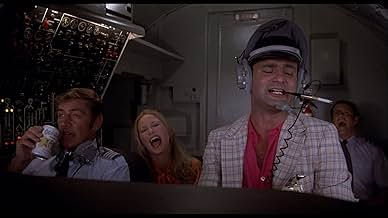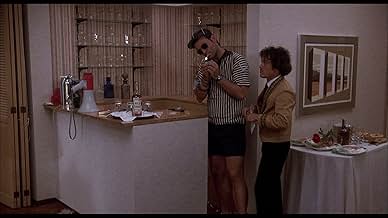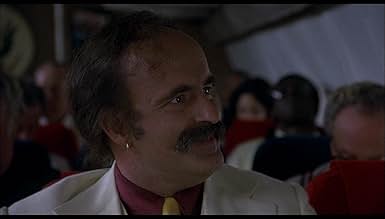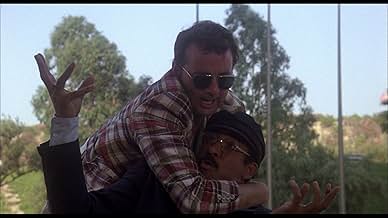CALIFICACIÓN DE IMDb
6.5/10
13 k
TU CALIFICACIÓN
Un recuento de la experiencia de vida del periodista Gonzo Hunter S.Un recuento de la experiencia de vida del periodista Gonzo Hunter S.Un recuento de la experiencia de vida del periodista Gonzo Hunter S.
- Dirección
- Guionistas
- Elenco
Rene Auberjonois
- Harris
- (as René Auberjonois)
Jon Shear
- Billy Kramer
- (as Jon Matthews)
Quinn K. Redeker
- Pilot
- (as Quinn Redeker)
- Dirección
- Guionistas
- Todo el elenco y el equipo
- Producción, taquilla y más en IMDbPro
Opiniones destacadas
Whether you like this film or not will depend heavily on how big of a Hunter S. Thompson fan you are.
On the plus side, this film is wickedly funny. Bill Murray (an actor who has been both great and terrible in his career) does a phenomenal job as the acid-drenched reporter, bringing chaos into the lives of the rigid and pretentious. The plot is peppered with "respectable" places being dragged into mayhem, and "respectable" folks trying (unsuccessfully) to cope behind plastic smiles.
It even ventures into some higher themes, such as innocent kids being jailed by a heartless criminal system, and Thompson's own struggles between being a practical reporter and a fun-loving idealist (notice how Lazlo repeatedly re-surfaces just when Thompson starts to take on "real" jobs).
It's biggest fault, however, was that it failed to achieve any of the higher accomplishments of HST's writings. What makes Thompson such a powerful writer (to me, anyway) is the way he'll often turn on a dime and deliver stunningly sober dialogs on the human animal and where he's gone wrong. Nestled in the midst of the wine, women, and song are soliloquies that drive home a more positive message, and none of those made it into this film (in fact, no significant chunks of actual text from HST's books appeared at all). It's like they shaved off the surface 50% of Thompson's work and discarded the rest.
Compare this to Fear and Loathing, which was darker and more counter-cultural, and contained whole narrations excerpted from the novel. The latter perhaps has less appeal to the average viewer, but I'd think more to a Thompson fan.
All-in-all, this film is a light-hearted romp into anarchy, and worth watching. But if you've never actually READ Thompson, do so, as this movie doesn't accurately represent him.
On the plus side, this film is wickedly funny. Bill Murray (an actor who has been both great and terrible in his career) does a phenomenal job as the acid-drenched reporter, bringing chaos into the lives of the rigid and pretentious. The plot is peppered with "respectable" places being dragged into mayhem, and "respectable" folks trying (unsuccessfully) to cope behind plastic smiles.
It even ventures into some higher themes, such as innocent kids being jailed by a heartless criminal system, and Thompson's own struggles between being a practical reporter and a fun-loving idealist (notice how Lazlo repeatedly re-surfaces just when Thompson starts to take on "real" jobs).
It's biggest fault, however, was that it failed to achieve any of the higher accomplishments of HST's writings. What makes Thompson such a powerful writer (to me, anyway) is the way he'll often turn on a dime and deliver stunningly sober dialogs on the human animal and where he's gone wrong. Nestled in the midst of the wine, women, and song are soliloquies that drive home a more positive message, and none of those made it into this film (in fact, no significant chunks of actual text from HST's books appeared at all). It's like they shaved off the surface 50% of Thompson's work and discarded the rest.
Compare this to Fear and Loathing, which was darker and more counter-cultural, and contained whole narrations excerpted from the novel. The latter perhaps has less appeal to the average viewer, but I'd think more to a Thompson fan.
All-in-all, this film is a light-hearted romp into anarchy, and worth watching. But if you've never actually READ Thompson, do so, as this movie doesn't accurately represent him.
Fist of all, as far as the comparison to Fear & Loathing In Las Vegas (1998) goes, these films are completely different beasts. Fear & Loathing is a adaptation of a fictional work based on real events. Johnny Depp and Benicio Del Toro are playing Raoul Duke and Dr. Gonzo, not Hunter S. Thompson and Oscar Zeta Acosta. They are playing caricatures of real people, indirect representations funneled through HST's imagination and exaggeration. Where The Buffalo Roam is more based in reality. Bill Murray is directly playing Hunter S. Thompson as he writes his writings, Johnny Depp played a character from his writings, there is a massive difference. And as such, in my opinion, both films succeed brilliantly. Fear & Loathing In Las Vegas is a visually dazzling, imaginative, cinematic adaptation of HST's novel and Where The Buffalo Roam is a quirky, splendidly fun quasi-biographical journey and pure snapshot of life.
Bill Murray is fantastic in this film. His portrayal of HST is taken from life, more realistic, more from the man rather than from his text or the legend of HST. The whole film itself, mainly because of Murray's characterization and the realistic structured style of the abrupt interconnected randomness of everyday life, is infused with a undying sense of fun and love for words, imagination, writing, and the whole creative process, which seems to me to get more to the core of HST as a man than the various vignettes of Fear & Loathing.
Where The Buffalo Roam is wildly entertaining, frenziedly hilarious, and immeasurably fun. But when the general viewing audience, who presumably do not have a true passion for HST and his works, views both films and are given the choice between the legend and the man, they more often choose the legend, which is usually the trend in history.
Whereas Fear & Loathing In Las Vegas has a romance for the stories and the myth, Where The Buffalo has a romance for the man and the process, and both have it for his personal style, politics and priorities.
Bill Murray is fantastic in this film. His portrayal of HST is taken from life, more realistic, more from the man rather than from his text or the legend of HST. The whole film itself, mainly because of Murray's characterization and the realistic structured style of the abrupt interconnected randomness of everyday life, is infused with a undying sense of fun and love for words, imagination, writing, and the whole creative process, which seems to me to get more to the core of HST as a man than the various vignettes of Fear & Loathing.
Where The Buffalo Roam is wildly entertaining, frenziedly hilarious, and immeasurably fun. But when the general viewing audience, who presumably do not have a true passion for HST and his works, views both films and are given the choice between the legend and the man, they more often choose the legend, which is usually the trend in history.
Whereas Fear & Loathing In Las Vegas has a romance for the stories and the myth, Where The Buffalo has a romance for the man and the process, and both have it for his personal style, politics and priorities.
Both of the HST films have problems. This film's problem is that it is too "screenwritten" (Lazlo replacing The Brown Buffalo, "Blast" Magazine replacing Rolling Stone, etc.) and lacks the weird surrealism that a drug-fueled observation of American culture at the end of the 1960s deserves, if not requires.
It does play a bit like Caddyshack, as someone else pointed out, and it's hard to get really invested in the characters. And if you love HST as much as I do, you really do want to get into the characters and in to the story, because it's as important as it is funny. Where the Buffalo Roam is, for the most part, silly. It comes off as more a bunch of sketches than anything else. I did like Bill Murray in the part. The problem is the script, more than anything else.
Fear and Loathing in Las Vegas, by contrast, does well with the surrealism and depravity but fails to make the full point I think Thompson was trying to get across - the decadence and over-the-top performances (especially of del Toro) are distracting, and really all of this is supposed to be about the death of the American dream, and the end of what was (to some) the best decade on record, or at least the one where people thought, for a time, they could make something of American life. Both movies hint at this but don't go into it enough, in my opinion.
Where the Buffalo Roam captures a little of the sadness and the creeping hopelessness of the early 70s (along with an indication of the hangover awaiting that generation in the 70s), but both movies fall far short of Thompson's books and writing in my opinion.
I was particularly saddened that both movies left out the "We're looking for the American dream" bit at the taco stand, because I think that was important, and the F&L Vegas story seems decontextualized without it (in terms of having a fairly serious (and sad) point under all of the humor and excess).
In any case, both movies are worth a watch but ultimately unsatisfying. Thompson is still best read. I think a good film about HST can be made, but the right person needs to be at the helm.
Richard Linklater or John Sayles, perhaps...someone who isn't going to miss the deeper substance underlying and buttressing the humor. That being said, there are far worse movies you could be watching than either.
And like Thompson, it still hasn't gotten weird enough for me.
It does play a bit like Caddyshack, as someone else pointed out, and it's hard to get really invested in the characters. And if you love HST as much as I do, you really do want to get into the characters and in to the story, because it's as important as it is funny. Where the Buffalo Roam is, for the most part, silly. It comes off as more a bunch of sketches than anything else. I did like Bill Murray in the part. The problem is the script, more than anything else.
Fear and Loathing in Las Vegas, by contrast, does well with the surrealism and depravity but fails to make the full point I think Thompson was trying to get across - the decadence and over-the-top performances (especially of del Toro) are distracting, and really all of this is supposed to be about the death of the American dream, and the end of what was (to some) the best decade on record, or at least the one where people thought, for a time, they could make something of American life. Both movies hint at this but don't go into it enough, in my opinion.
Where the Buffalo Roam captures a little of the sadness and the creeping hopelessness of the early 70s (along with an indication of the hangover awaiting that generation in the 70s), but both movies fall far short of Thompson's books and writing in my opinion.
I was particularly saddened that both movies left out the "We're looking for the American dream" bit at the taco stand, because I think that was important, and the F&L Vegas story seems decontextualized without it (in terms of having a fairly serious (and sad) point under all of the humor and excess).
In any case, both movies are worth a watch but ultimately unsatisfying. Thompson is still best read. I think a good film about HST can be made, but the right person needs to be at the helm.
Richard Linklater or John Sayles, perhaps...someone who isn't going to miss the deeper substance underlying and buttressing the humor. That being said, there are far worse movies you could be watching than either.
And like Thompson, it still hasn't gotten weird enough for me.
Most negative reviews seem to come from people who saw Depp before Murray. Pity. For serious HST readers or even those who only know The Great Shark Hunt, WTBR offered a comic relief side so sadly lacking in Depp's one-dimensional, cardboard, just quote your lines performance (and I'm a big Depp fan). As for "Murray being Murray" - such a comment can only come from people who saw this after the rest of Bill's work. It was one of the earliest and best - indeed laid the base for much of his 80s and 90s work. Boyle is frenetic, allowing Murray to play sidekick for a change. A great option. HST's written rants were always harsh but always fair, no doubt composed coming off a bender. Who then is to say WTBR's omission of much of these is wrong, rather than simply a portrayal of the benders. We all know what he wrote and how he wrote - I'm glad WTBR chose to portray who HST was and the chaotic situations he put himself in rather than become some art-house naval-gazing about the tortured creative process of a scathingly intelligent commentator. Mind you - I did see it as the second part of a double header with Eraserhead ! Sadly, no video copies of WTBR exist in Australia. Can anyone help me ?
The comparison of WTBR and F & L is pointless. Each actor brings something different to their version of HST, his "lawyer" etc . . . Gilliam certainly brought his own style to the more text based project, but enough of that. You'll see plenty of conflicting viewpoints in the other comments. Which WTBR you see will determine how much you like or dislike this film will depend on which version you see. I've seen at least three versions of this movie, and possibly a couple more. And although essentially the same movie, they're all totally different. The adding of a simple 30 second scene changed the entire tone of the film in one version. In another it was just the soundtrack that was changed. It was as though they lost the rights to the original soundtrack -- or just couldn't keep up the payments -- and had to replace the tunes with some second-stringers. It's amazing how much something like changing the songs in the soundtrack effects the feel of the thing as much as anything happening on screen. The original release is the only one really worth seeing. And you're not likely to. As far as I know, it doesn't not exist anymore. I caught it on cable when it was fairly new. All of the versions I've seen since on TV or video were the inferior versions that have the added scenes and or the adulterated soundtrack. So even if you've mat have seen this movie, you probably still haven't.
¿Sabías que…?
- TriviaTo get into character, Bill Murray spent time with Hunter S. Thompson by drinking, shooting and generally having a great time at Thompson's Colorado ranch. After filming ended, Murray continued to act "Gonzo" through the beginning of the next season of Saturday Night Live (1975), to the annoyance and consternation of cast and crew members.
- ErroresDuring the courtroom scene, 21 minutes and 5 seconds into the film, Thompson sets down his glass which is almost full. A second later, a close-up on the glass shows it sitting on the floor, empty. All further scenes in the courtroom show the glass once again almost full.
- Citas
[Thompson is speaking to a crowd of college students]
Questioner: I was just wondering if you could tell me, um, if you thought drugs and alcohol would make me a better writer.
Dr. Hunter S. Thompson: That's a good question. Let me see...
[the audience cheers as Thompson lights a joint. A few people throw joints onto the stage]
Dr. Hunter S. Thompson: In my case, you know, I hate to advocate drugs or liquor, violence, insanity to anyone. But in my case it's worked.
- Versiones alternativasThe 2017 Blu-ray release from Shout! Factory restores the original soundtrack. Making this the first home media release since the original VHS release to feature the original unaltered soundtrack.
- Bandas sonorasKeep on Chooglin
Written by John Fogerty
Performed by Creedence Clearwater Revival (as Credence Clearwater Revival)
Selecciones populares
Inicia sesión para calificar y agrega a la lista de videos para obtener recomendaciones personalizadas
Detalles
Taquilla
- Total en EE. UU. y Canadá
- USD 6,659,377
- Fin de semana de estreno en EE. UU. y Canadá
- USD 1,750,593
- 27 abr 1980
- Total a nivel mundial
- USD 6,659,377
Contribuir a esta página
Sugiere una edición o agrega el contenido que falta

Principales brechas de datos
By what name was Where the Buffalo Roam (1980) officially released in India in English?
Responda

































